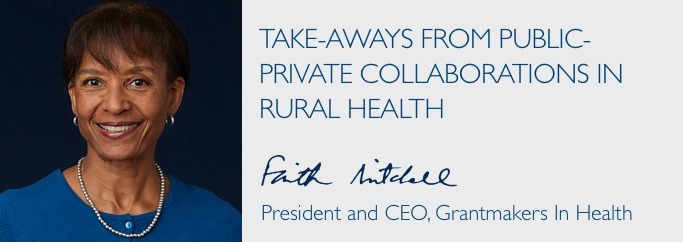
For the past seven years, Grantmakers In Health (GIH) has been part of the Rural Health Philanthropy Partnership, which convenes public and private foundations, researchers, and policy makers to discuss federal programs and foundation-led initiatives in rural areas. The Partnership meets annually in Washington DC at a gathering called Public-Private Collaborations in Rural Health. This year, in addition to GIH, the meeting was co-hosted by the Centers for Disease Control and Prevention, the Federal Office of Rural Health Policy, the National Rural Health Association, and the Office of Rural Health Policy (HRSA). It focused on the social determinants of health as a frame for understanding challenges to rural health. The discussion included economic development, housing, the opioid epidemic, and promising foundation initiatives.
One of my main take-aways from the meeting was the importance of grounding our discussions of rural health in broader social and economic frameworks—and within broader philanthropic strategies. It’s true that certain features, especially low population density and limited infrastructure, characterize rural areas, but in important respects they are more like urban and suburban communities than unlike them. For example, both rural and urban communities face the challenges of investing in economic development, providing adequate levels of affordable housing, and improving access to preventive health services and health care. Both geographies are demographically diverse; in this respect, rural communities as a whole are more diverse than many people realize. And conditions in rural communities are shaped by social and economic trends that are regional, national, and—increasingly—global in origin. How can we understand and address rural challenges in isolation from these larger developments?
Similarly, it makes sense for philanthropy to make rural areas part of broader grantmaking strategies. For one thing, few funders serve rural areas exclusively. That is certainly true of GIH’s Funding Partners, most of whom have rural areas within their service areas, as well as urban and suburban communities. It makes sense that these funders’ approaches to building community health and improving health care would be designed to embrace the full range of communities within their jurisdictions. And, of course, rural communities are not static. For example, research tells us that with time many rural areas become more suburban in nature. Thus, if funders “silo” their thinking about rural communities (no pun intended!), they risk losing sight of long-term trends that will affect health and well-being.
Another key meeting take-away for me was that funders cannot use a “one size fits all” approach to addressing rural health. Instead, being sensitive to racial, political, and cultural differences, organizational capacity, and other considerations will lead to more successful relationships with rural communities—just as it does in urban communities. Similarly, active outreach to meet with members of rural communities helps—just as it does in cities. In other words, there are two related principles that guide more effective rural philanthropy: 1) being open to, and aware of, specific sensitivities that are in play in communities; and 2) understanding that this same awareness should be part of every philanthropic relationship.
Looking forward to 2020’s rural health meeting, we hope to include a focus on rural children’s health. Because rates of child poverty are higher in rural areas than they are in cities, and educational and employment limitations create barriers to well-being, rural children face major problems that are compounded by geographic isolation and the limited availability of social services and health care. There are many opportunities for public and private funders to make a difference.

